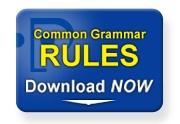People over fifty should see their doctor about a colonoscopy at least every five years. But that's something for another letter, another time, and another doctor. Let's talk about the simple colon--the printed character.
A colon introduces an element or a series of elements illustrating or amplifying what has preceded the colon. Between independent clauses it functions much like a semicolon, though more strongly emphasizing sequence. The colon may be used instead of a period to introduce a series of related sentences (as in the fourth example below). Colons are also used in URLs; no space precedes or follows a colon in a URL. A colon should never be immediately followed by a dash: either a colon or a dash suffices.
Lowercase or capital letter after a colon? When a colon is used within a sentence, as in the first three examples above, the first word following the colon is lowercased unless it is a proper noun. When a colon introduces two or more sentences (as in the fourth example above), or when it introduces a speech in dialogue or an extract, the first word is capitalized. (See examples in following rules.)
With "as follows" and the like. A colon is normally used after as follows, the following, and similar expressions.
Introducing speech. A colon is often used to introduce speech in dialogue or an extract.
With introductory phrase. At the beginning of a speech or a formal communication, a colon usually follows the identification of those addressed.
Inappropriate uses of colon. A colon is not normally used after namely, for example, and similar expressions. Nor is it used before a series introduced by a verb or a preposition.
With parentheses or brackets. When the context calls for a colon at the end of material enclosed in parentheses or brackets, the colon should follow the closing parenthesis or bracket.
Source: The Chicago Manual of Style.
A colon introduces an element or a series of elements illustrating or amplifying what has preceded the colon. Between independent clauses it functions much like a semicolon, though more strongly emphasizing sequence. The colon may be used instead of a period to introduce a series of related sentences (as in the fourth example below). Colons are also used in URLs; no space precedes or follows a colon in a URL. A colon should never be immediately followed by a dash: either a colon or a dash suffices.
- The tournament covers three contests: slalom, trick skiing, and jumping.
- They even relied on a chronological analogy: just as the Year II had overshadowed 1789, so the October Revolution had eclipsed that of February.
- Many of the skiers held day jobs: thirteen of them, for example, moonlighted as surfboard shapers.
- Sassafras was faced with a hideous choice: Should she reveal what was in the letter and ruin her reputation? Or should she remain silent and compromise the integrity of the judges?
- You should be able to find an archived version of the article at http://www.allworldnewspapers.com.
Lowercase or capital letter after a colon? When a colon is used within a sentence, as in the first three examples above, the first word following the colon is lowercased unless it is a proper noun. When a colon introduces two or more sentences (as in the fourth example above), or when it introduces a speech in dialogue or an extract, the first word is capitalized. (See examples in following rules.)
With "as follows" and the like. A colon is normally used after as follows, the following, and similar expressions.
- The steps are as follows: first, put a vest on; second, grab a rope and jump in; third, put the ski on; fourth, hold on!
- I argue for the following propositions: First, . . . Second, . . . Third, . . .
Introducing speech. A colon is often used to introduce speech in dialogue or an extract.
- Michael: Are you ready?
Dorothy: Hit it! - Mortimer Dareuman, author of Learn to Water Ski in Ten Seconds, starts his book boldly: "When you're in the water with your skis and you see an alligator swimming toward you with its mouth wide open, ..."
With introductory phrase. At the beginning of a speech or a formal communication, a colon usually follows the identification of those addressed.
- Ladies and Gentlemen:
- To Whom It May Concern:
- Dear Credit and Collections Manager:
Inappropriate uses of colon. A colon is not normally used after namely, for example, and similar expressions. Nor is it used before a series introduced by a verb or a preposition.
- The story involved the three most critical issues, namely, who competed, who won, and who went to the hospital.
- An application should include educational background, work experience, and other relevant experience.
- This manual is concerned with (1) the steering wheel, (2) the rudder, (3) the GPS, and (4) the compass.
With parentheses or brackets. When the context calls for a colon at the end of material enclosed in parentheses or brackets, the colon should follow the closing parenthesis or bracket.
- A change occurred in the behavior of the animals (rhesus monkeys): they had become hypersensitive to sound.
Source: The Chicago Manual of Style.




